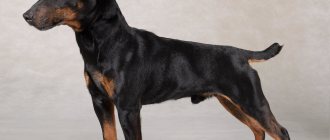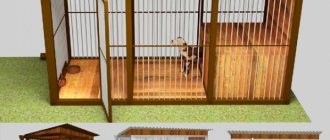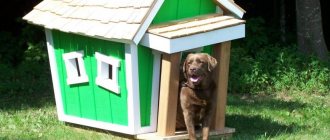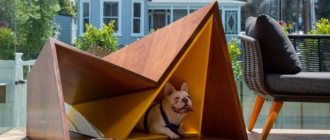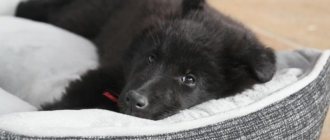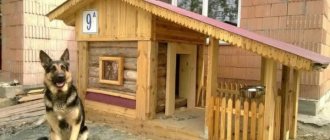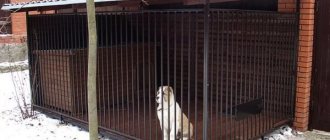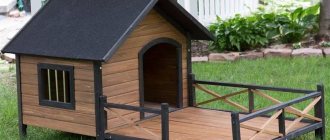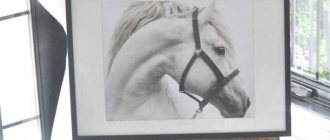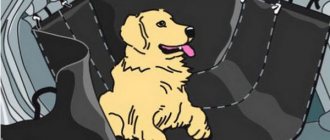What is an aviary
An aviary is a fenced area for keeping poultry, pets and dogs. It may or may not be covered.
One of the options for respectable pets
A dog enclosure is a building in which an animal can be kept. For large dogs, the enclosure is made outdoors, and in such a way that it can withstand the pressure of the animal for a long time.
This is an enclosure (fence) for small dogs
For small domestic dogs, an enclosure usually means a portable fence that allows you to limit their movement. The same enclosures are usually needed for older puppies, so that they do not wander around the house.
Enclosure sizes
To make an aviary with your own hands, you will first need to decide on the size. It all depends on the breed, or rather, on the size of the dog. The larger it is, the more spacious the enclosure it needs for normal well-being. For shepherds, huskies and other not too large dogs, a pen with an area of 6 meters per individual is sufficient. For Alabais, Caucasian Shepherds, Mastiffs and other large breeds, much more is needed. If the pen is considered only for “locking it while someone comes,” then you can fence off the same 6 squares. Otherwise - at least 8
We assume that the depth of the pen is desirable to be at least 2 meters. The width “emerges” from the required area and the available free space.
Recommended enclosure area for large and medium dogs
Usually the enclosure is made covered. You can leave part of the area without a roof so that your pet can bask in the sun if desired. But you shouldn’t leave the area unprotected: either your dog will run away or someone will come to visit. Instead of a “normal” roof, there may be a lattice made of rods - there is enough light and there are no surprises to expect.
If the dog will spend the winter in the enclosure, you can provide a winter road or install an insulated booth. Most likely, your watchman will like the second option better. They often prefer to sit on the roof of the booth, since there is a better view from there, and not everyone agrees to go into the closed part - they can’t see anything. You can quickly stick your head out of the booth, but you have to run out of the winter road. In general, you better know your pet's personality. An enclosure is not always built because it is cheaper, but so that it is durable, reliable and comfortable for the animal.
What height should a dog's enclosure be? Since it’s up to you to clean anyway, the height is taken so that you can move inside without problems. Usually the height is from 180-185 cm, but depends on the height of the owner.
Northern regions may require an insulated winter road
If you are going to keep a dog in an enclosure only for a short period of time - neighbors, construction crews, etc. will come. — they only make a pen with a roof. If you plan to leave the animal behind the fence for a long time, you also need a booth. It can be placed inside or attached.
Dog house: construction recommendations and reviews from dog breeders
Construction recommendations and reviews:
Alexey, 40 years old. I live in my own house, I have a Labrador. I started it 2 years ago. At that time I was not working, so I could afford to build a booth. Spent about 4 days. I made it from old pallets, I think it turned out quite nice. The building was insulated using polystyrene foam. I made the roof pitched and covered it with bitumen shingles. He did it in vain; the dog chewed off part of the roof. It's good that I didn't get poisoned. I was forced to remove this roof and screw on regular galvanized roofing. I selected the size, but did not take into account the dimensions of the dog; at that time he was a puppy. I was guided by the average data of the breed.
Alexey, 35 years old. I have a small poodle, initially we lived in an apartment, but then we moved into our own house. The baby lived with us in an apartment, but in his own house there is a lot of free space, there is an area near the house, so I decided to build his own home for him. Surprisingly, the dog really liked it, she enjoys relaxing there on hot days, in the shade. Made from old furniture. I had a chest of drawers that I smashed and then built a booth. The roof was made from corrugated sheet metal. It remained in the barn after renovation. Very happy, the kennel does not leak. I didn’t insulate it with anything, we feel sorry for Nancy, she lives in the house with us in the winter.
Oleg, 27 years old. We have a German Shepherd, we got her a long time ago. The house is big, but Bucks is a pest, so he often digs up vegetables in the garden. We decided to make an enclosure and a booth for her. Made from brick. I think this material is not the best, but at that time construction was underway, so there was a lot of such building material. Didn't insulate the inside with anything. We'll have to take care of insulation somehow, the kennel is cold. Covered with slate. Overall it turned out well, but it seems to me that Baksu is a little cramped in it.
Structure
Remember that housing for an animal must be comfortable. Some owners provide special canopies or verandas for such purposes. In fact, they divide the booth into two parts, one of which is left open, and the second is closed by installing a roof. In hot weather, the dog can rest in this part and not enter the building.
Choosing a location for an aviary in the yard
You want to make an enclosure so that your pet feels good, so you need to take into account its character and habits. While in the enclosure, the dog will continue to guard its territory, so it is best to fence off the area on a hill, if there is one. It is very good if the entrance to the house, the entrance to the site is visible, or at least it will be possible to track one of these important points. When choosing a place, keep in mind that your pet needs to see you at least from time to time. You or family members. Otherwise, whining and howling are guaranteed, especially if the dog is not used to restrictions.
When choosing materials, keep in mind that everything that can be chewed will be chewed
When choosing a location, pay attention to the following points:
- It is better to retreat at least half a meter from the nearest building or fence, otherwise you will not be able to clean the debris from there.
- The enclosure should not be in danger of snow melting. If a huge mass suddenly falls onto the roof with a corresponding sound, the dog will receive a shock. It will be very difficult to drive her into an enclosure.
- The structure must be unfolded so that the open part faces southeast or southwest. In the northern regions, it is preferable to go south. Just don't go north.
- It’s not bad if there is a massive bush or spreading tree nearby - they will protect you from the wind and heat.
Taking all these wishes into account is far from easy, but it depends on how well the pet will feel.
How to choose dog house options
The dimensions of the dog house are chosen taking into account the fact that a large volume retains heat less well in winter, but at the same time the dog will not like the cramped space. In other words, one should strive for optimal sizes, which means they are selected individually for each animal, taking into account its size. It should be understood that the pet must be able to calmly stand, sit and lie inside, and turn around if necessary. It is necessary to take into account even such nuances as the dog’s desire to curl up or stretch, bring and gnaw on a favorite bone or hide it, as well as other individual characteristics of the animal (Fig. 2 Dimensions of the booth).
Choosing the right booth size
The height of the booth is selected as follows: the height of the animal at the withers with an addition of 15-20 cm. The depth of the internal space should allow the dog to fully stretch out while lying on its side, i.e. the following rule is followed: the length of the dog from the tip of the tail to the claws of the front paws extended forward with an addition of 12-16 cm. The width of the kennel should allow the dog to lie across, that is, the dimensions should be no less than the length of the animal from the tip of the nose to the tail plus 10-15 cm.
The size of the hole or entrance to the house is important. It cannot be too large so as not to let in the cold in winter, but at the same time allow it to quickly pop out if necessary. The following parameters are recommended for choosing the size of the hole: height - dog height at the withers plus 6-12 cm, width - chest width plus 6-10 cm. The shape of the hole can be rectangular or round (most often only on top).
Here are some recommendations for choosing the size of a dog house:
| Types and some breeds of dogs | Booth dimensions in cm | Entry size in cm |
| WxDxH | WxH | |
| Kennel for small breed dogs (pug, Pekingese, dachshund, fox terrier, lapdog) | 70x56x65 | 30x45 |
| House for medium dogs (boxer, sharpei, rottweiler) | 120x76x80 | 36x55 |
| Large kennel for large dogs (Great Dane, Caucasian or Asian Shepherd) | 140x100x96 | 45x65 |
Design requirements and materials
Large breed dogs with good coats are not afraid of the cold. If they are outdoors all the time, they grow a thick undercoat, which perfectly protects them from the cold. It is much worse for them if they are either warm or cold. What’s also bad for them is a draft. Then a thick undercoat does not help. Therefore, one of the long walls of the enclosure must be sewn up; one or two of the short ones may be closed. With this device, in any direction of the wind you can find calm and the dog does not have to climb into the kennel.
At least two adjacent walls must be sewn up
Contents of the drathaar
Drahthaar dogs are distinguished by their unpretentiousness and ease of maintenance. They need to be washed as needed, and their short coat, up to 3 centimeters long, does not require special care. Keeping these dogs in urban environments does not present any particular problems. It is enough to arrange long walks together in the park, swims on the lake or morning jogs.
When walking the Drahthaar, you don’t have to worry about conflicts with stray dogs or cats, since German Wirehaired Pointers have a very calm and balanced character. For his comfortable stay in a city apartment, you need to choose a place that is located away from the heating system and the corridor.
Train your drathaar puppy to his bed or rug in advance, and you will always be able to find him in his place. Dogs of this breed feel much better in the fresh country air. The versatility of the drathaar allows its skills to be used not only for hunting, but also for protecting a personal plot. Build a booth with an enclosure for him and you won’t have to worry about the safety of your property.
You can buy a booth for a drathaar using the catalog presented in one of the sections of our website. If you have enough free time and a desire to please your four-legged friend, we will tell you how to build a doghouse for a drathaar with your own hands
.
Continental Pointer Breeds
German Shorthaired Pointer
Height: 58-66 cm.
Weight: 20-32 kg.
Country of origin: Germany.
This is a German shorthaired pointer, bred in Germany from older German breeds of pointers that previously hunted birds with nets. Later they became more versatile and learned to hunt with a gun.
Today, this popular breed continues to be improved by breeders; the dogs are able to carry out all hunting commands even in old age. The color can be very different: from deep black to coffee with many spots.
The shorthaired pointer can hunt birds and small animals. He does best hunting in the field, he swims beautifully even in icy water, brings game to the feet of his owner, follows a trail of blood, etc.
German drathaar
Height: 57-68 cm.
Weight: 23-32 kg.
Country of origin: Germany.
This breed of pointing dog was bred in Germany at the end of the 19th century. She is of medium height and brown in color with spots. The drathaar's tail is usually docked if the dog is to be used for hunting.
The breed is very popular among hunters all over the world. She perfectly hunts not only birds, but even wild boars, taking a stance or barking at the animal if necessary.
The hard coat protects the drathaar from the cold and insects. In search of a shot bird, it swims beautifully even in cold waters. Never shows any aggression towards people, good friend.
Hungarian Vizsla
Height: 54-64 cm.
Weight: 20-27 kg.
Country of origin: Hungary.
This Hungarian pointer is considered one of the smartest and most talented dogs in the world. In addition, she has a very impressive appearance and an elegant gait. The ancestors of this dog appeared in the Carpathians in the 10th century with the nomadic Magyar tribes.
Their bright red or gold color attracted the Hungarian nobility. The dogs were their absolute favorites not only for their beauty, but also for their excellent hunting talents: a keen sense of smell, excellent stance, the ability to hunt anywhere, etc.
The Hungarian Vizsla is of average height and has a beautiful, muscular build. This is a very good-natured and friendly dog that shows virtually no aggression. He loves an active lifestyle and requires constant walks and exercise.
Italian bracque
Height: 55-67 cm.
Weight: 25-40 kg.
Country of origin: Italy.
This is an Italian pointer, which is used for hunting birds, although it is a universal hunter, it can also hunt rabbits. Italian breeders believe that the Braccus appeared in the 4th century and is descended from the Molossians.
Bracchi were extremely popular among the noble families of Italy during the Middle Ages. Back then, bird hunting was considered a sign of aristocracy. And at the end of the 19th century, these dogs almost disappeared. It took a long time to restore the breed.
The standard for the Italian cop appeared only in the middle of the 20th century, at which time it was officially recognized. This is a very strong and passionate dog that is simply eager to hunt. In between hunts, she can be a wonderful companion.
Weimar pointer
Height: 57-70 cm.
Weight: 30-40 kg.
Country of origin: Germany.
The ancestors of the Weimar pointer hunted big game hundreds of years ago. She has a high level of intelligence, is well trained and obeys her owner. This breed appeared, was recognized and registered at the end of the 19th century.
The Weimar Pointer is of medium to tall height and has a harmonious, muscular build. Color – antique silver. That is why the dog has the nickname “silver ghost” in Germany.
The Weimaraner is a very active dog that loves to learn and perfectly absorbs new material. She is mobile, active, and loves to always be ahead. The good-natured and gentle Weimar Pointer never shows aggression towards humans.
Epagnol Breton
Height: 46-52 cm.
Weight: 14-18 kg.
Country of origin: France.
The Breton Epagnole is a French pointing dog, one of the most popular hunting breeds in Europe and America. He has high intelligence and an excellent sense of smell. Puppies begin to hunt at 4 months.
Their existence was first mentioned in French paintings of the 17th century. And information about the formed breed appeared in specialized literature only in the middle of the 19th century. The breed was officially recognized at the very beginning of the 20th century.
This is a very sociable and obedient dog that loves to hunt birds. She is capable of running very fast and following a trail of blood, and can fetch from birth. Bretons work in extreme heat and sub-zero temperatures.
DIY drathaar booth
Before starting the construction of a booth for a drathaar, it is necessary to choose the right location, decide on the project and prepare building materials. The place for the dog house should be on a small hill near the fence, from where the entire plot of land can be clearly seen. The fence will provide protection from the wind and provide enough shade on a hot day, and the elevation will not allow excess moisture to accumulate under the bottom of the booth.
Dogs of this breed are quite curious and love to lead an active lifestyle, so the dog will feel comfortable in a booth with a pitched roof installed in the corner of the enclosure. The best building material for a dog house is wood.
Based on this fact, prepare in advance bars 5 to 10 centimeters thick, planed boards that do not have flaws in the form of knots and splinters. To protect the bottom of the dog house, take a sheet of roofing felt. Soft tiles or slate are suitable as roofing materials. If it is expected that the dog will live in his house all year round, then you need to take care of additional insulation of the walls.
When constructing the walls of the enclosure, only one of them is made blank; the remaining three are better covered with chain-link mesh.
Box installation
Now it’s the turn of the walls of the house. To do this, cut two sections from a 100 x 100 mm beam equal to the height of the booth. Make two more pieces 10 cm longer. They will subsequently support the pitched roof.
Attach the finished racks to the corners of the booth. You can strengthen them with braces or metal corners. In front of the booth on the entrance side there should be longer bars. From the back - shorter. Thus, we will form the correct slope of the pitched roof. It is also necessary to strengthen the walls of the kennel. To do this, you need to fix two beams of smaller height on the entrance side. And it is advisable to fix two racks in the center of the side and rear walls. Be sure to tie the racks with 40 x 40 mm timber. Mount it at the highest point of the low supports.
Thus, we have a frame that now needs to be sheathed. Make the walls from clapboard, plywood or logs (you can take the material left over from building a house and first saw it in half lengthwise).
As soon as the box is ready, it needs to be insulated from the inside according to the principle of the floor. That is, we first lay waterproofing material on the walls. Then we install the insulation boards. And only then we cover the walls with clapboard, boards or plywood. As a result, we received an insulated box from the walls and bottom.
Important: When installing the front wall of the booth, do not forget to first cut out the entrance window. It can be square or round. This is not important.
Building a booth for the drathaar
Having measured the dog in its lying, sitting and standing position, you need to add 10 centimeters to the results obtained, so you will get the dimensions of the kennel. To determine the dimensions of the drathaar booth
- You first need to determine the size of the width of the opening. To do this, you need to add 5 centimeters to the width of the dog’s chest, and to find out its height, you need to subtract 5 centimeters from the pet’s height at the withers. We construct the base of the booth from bars, to which a sheet of roofing material is attached, on top of which floor boards are sewn. Next, you can begin installing the walls.
For internal wall cladding, moisture-resistant plywood or lining is used, and for external wall cladding, boards, OSB, sandwich panels or block houses are ideal. The advantages of these materials can be found in interesting articles posted in one of the sections of our website.
The booth wall is filled with heat-insulating material, such as mineral wool, felt or polystyrene foam. The pitched roof should have a slight slope towards the back of the booth. This is necessary for the drainage of melt or rainwater.
It is strictly not recommended to cover the roof of the booth with roofing iron or roofing felt, as roofing felt melts in the sun, releasing toxic fumes, and the metal becomes very hot. If you decide to install a gable roof, the attic space can be used to store dog toys and other supplies. Having built the booth, you can begin building the enclosure.
Origin story
Already at the beginning of the 18th century in Europe there were several breeds of large-chested hunting dogs. In France - griffins, in the territory of modern Poland - wire-haired bird dogs, which originated from crossing smooth-haired pointers and barbets. In Germany there were also native broad-chested dogs, but at that time they were not widespread, since German hunters were carried away by English pointers with short hair. Only a few decades later did the Germans notice that their local wire-haired dogs were appearing at shows in indecently small numbers and decided to correct the situation.
A society called the Deutsch-Drathaar (DD) was organized, which set the goal of uniting all existing wire-haired breeds and developing a versatile working dog, suitable for hunting birds and animals, well built with a practical coat. The basis was taken from existing breeds of wire-haired pointers of German, French and Belgian origin: the Korthals Griffon, the Stichelhaar, the Pointer Poodle, and the Shorthaired Shorthaired Pointer. The breed standard was approved already in 1924.
The name of the breed emphasizes the main distinguishing feature of the dogs and is formed from two German words: Draht - “wire” and Haar - “hair”.
In Russia, drathaars began to appear even before the October Revolution, but they became widespread only in the post-war years, when a population of wire-haired pointers of various breeds was imported from Germany. Further selection was aimed at improving hunting qualities: improving sense of smell, strengthening the stance and speeding up the search. They took the German Drahthaar as a standard and essentially bred it again, repeating the path of German breeders, but more adapted to harsh climatic conditions.
Video review about the German Drathaar dog breed:
https://youtube.com/watch?v=JCRTvAW-mQo
We are building an aviary
Drathaars are adapted for running over rough terrain, so it is not recommended to make the floor in the enclosure asphalt or covered with paving stones. A lawn or gravel surface is ideal for flooring.
More complete material on building an enclosure for a draathar can be found here.
The dog needs to keep his muscles in good shape and 10 square meters of enclosure area will be enough for him. As we already wrote above, one of the walls of the enclosure is made blank, and the rest are covered with chain-link. If the pet had enough shade over the enclosure, you can install a canopy.
If you want your pet to feel good while in a private home, you can build a dog enclosure with your own hands. This will not only provide your dog with a home, but also protect his health. In this article we will tell you everything about building the structure and provide detailed step-by-step instructions with dimensions and drawings.
Making a drawing
To properly design a dog house, you need to draw up a drawing of the kennel with dimensions. Relying on it, you can easily make a booth. We make a drawing for the house in accordance with the measurements taken. The diagram should include data on the width, height, depth of the structure and the diameter of the manhole. It will be good if you can draw a front view and a side view of the booth.
If you are afraid of making a mistake with the size of the dog house, then use the information from a special reference book.
Tip: the most durable, comfortable and long-lasting home for a pet will be made of wood. In addition, wood is one of the available materials that is inexpensive. The main thing is to take well-treated wood without burrs or knots. To avoid injuring the dog.
Interesting: House for a cat: ideas, drawings
General requirements for an aviary
If you decide to make a dog enclosure with your own hands, then in order to achieve a good result, you must meet certain requirements:
- Animal size. It is not recommended to save on space, but it also does not need too much space.
- Carefully consider the choice of building material from which the floor will be made. The best option would be to equip only part of the building with flooring.
- Part of the walls of the enclosure should be tightly sealed, and the second part can be made of lattice. Recently, you can increasingly find reviews on the Internet that the use of metal mesh only harms the animal - the dog can easily be injured.
- To protect your dog from rain and snow, carefully consider the presence of an awning or roof, mark its dimensions on the drawing.
- The door to the shepherd's enclosure should open inward.
- You should also pay attention to the construction of the booth inside the structure (the author of the video is Alexandra).
Preliminary work
Selecting a location
First of all, a large outdoor enclosure for a dog with your own hands should be built taking into account the choice of location.
This process has its own nuances and we suggest you learn about them:
- the arrangement of a cage with an awning should be carried out away from sources of noise or a fence, in particular if there is a busy street nearby;
- metal enclosures for dogs should be installed near the door to the house, this is necessary so that the dog can always see it;
- It is advisable to install home-made and ready-made prefabricated structures for a large dog, two dogs or puppies on a hill so that the dog can always control what is happening on the site;
- so that the animal’s sense of smell is not damaged, a cage with a net and an awning should be installed away from any compost pits or smelly places in principle;
- The entrance to the cage should be marked in advance on the drawing with dimensions and it must be installed on the east or west side, otherwise the animal will be too hot or cold.
Sizing
As we said earlier, before building an enclosure for a dog, it is necessary to take into account the size of the pet, which depends specifically on the size of the animal. If you have puppies or small animals, you can purchase a structure measuring about one and a half square meters in area. If the size of the dog at the withers is less than 50 cm, then the area of the future home should be about 6 square meters. meters.
If the size of the animal is larger - up to 65 cm, then the size of the cage with an awning should be increased to 8 “squares”. A big pet must live in an enclosure with an area of at least 10 sq.m.
If a structure is being built for two or more puppies, then its size should be increased by one and a half times. As for the height, it should be such that the dog can stand on its hind legs inside without any problems. The height may be slightly lower if a cage with a metal mesh and an awning is needed as a temporary place of residence.
Preparation of the drawing
A simple drawing for building a structure
An important point in the manufacture of a structure is the preparation of the drawing. The design of a metal cage with an awning for one dog or several puppies should be thought out in advance. The drawing is drawn up taking into account the above nuances, in particular, the size of the animal and other factors, for example, the presence of a booth inside. When constructing a drawing, all the nuances should be taken into account, so this step should be approached responsibly.
Where is the best place to install a kennel?
The location of the doghouse is selected taking into account climatic conditions, the location of buildings and the habits of the animal. Based on the climatic factor, the area where the kennel is being built should be protected from frequent and strong winds by a building wall, a permanent fence, etc. The house should not be placed in a completely open area where there will be constant sunshine: it is desirable that there is enough space light, but with shadow (possibly under a canopy). Frequent dampness should be excluded, which means there is no need to build a booth in a lowland - it is better if it is a slight elevation.
Any dog has the instinct of self-preservation and guarding the owners and territory.
Taking this into account, the booth should be located so that the animal, while inside, can observe all approaches to its home. In addition, the dog must see the entrance gate to the site, and preferably the entrance to the residential building. If such conditions are not met, the pet will not be calm. And at every rustle he will run out to assess the situation. It is advisable to choose an area at some distance from constant irritants, for example, where people often walk: a road, sidewalk or playground. Otherwise, frequent dog barking is guaranteed.
It is worth thinking about the approaches to the kennel. Firstly, a normal approach must be ensured, even after prolonged rains. Secondly, you should not move the house too far away, otherwise the owner will have to take a long walk to feed or water the pet, and in cold weather this is not very pleasant.
The booth must be installed in a suitable location
Instructions for building an aviary
Now let's talk about how to make an enclosure for a dog at home. Every dog breeder can cope with this task if he follows the requirements specified in the instructions below.
Tools and materials
The selection of materials must be carried out properly - they must be safe for your pet. For example, it is best to use a fine metal mesh to arrange a cage with an awning; a fine mesh will not allow the animal to be injured, but iron bars can cause injury - paws can easily get stuck in them.
The floor must be made of asphalt or concrete; the second option is preferable due to its ease of arrangement. However, in winter concrete can be too cold, this should also be taken into account. Ideally, wood should be installed on concrete. In general, the tree should cover at least a small area of the area - about two square meters. Instead of wood, you can use insulated crushed stone, and a solid foundation can be replaced with a point foundation to leave part of the earth for your pet (video author - Andrey Savin).
As for tools, there is a standard set that includes a hammer, nails, screws, etc. In general, everything that every owner has.
Stages
So, if you don’t know how to build a dog enclosure, then right now we will tell you in detail about this process.
- First, the lower part of the structure is built - the foundation is poured and the floor is made. Four pipes are driven in around the perimeter, after which gravel or expanded clay is poured here. Then the timber frame is laid. To avoid moisture accumulation in the dog’s home, at this stage you should consider a slight slope of the floor.
- The next stage will be the construction of fences. It is necessary to make a frame from pipes, but you should also take into account that the door will be located on the front wall, so another horizontal pipe should be installed here. After this, the walls need to be covered with wood or equipped with lattice.
- If your region has very cold winters, then wooden structural elements can be supplemented with ecowool or mineral insulation. When installing the mesh, it is important to consider that it does not tear under impact, otherwise this will lead to injury to the animal.
- The next step will be the installation of the roof - as mentioned above, any material can be used. As for fastenings, it is better to use screws or other hidden parts so that your pet is not injured.
- You also need to take into account that all wooden components of the structure must be pre-treated with sandpaper and varnish. This will not only increase the service life of the enclosure, but will also help improve its appearance.
Capital structure made of stone, brick, building blocks
If the booth is built in one place forever, and this often happens in a small yard, then a permanent structure is most suitable. The main advantage of such structures is not strength and durability. Stone, including artificial stone in the form of monolithic concrete, is a natural material.
A shelter or shelter made of stone is similar to a hole or cave in natural conditions . If such an artificial hole is kept dry and clean, then a better home for a yard guard is not needed. Below in the photo is the principle of constructing a burrow booth: such options are easier to implement in stone or monolithic concrete.
Monumental stone booth
Recommendations for sanitation of a doghouse are, in principle, correct and justified, but it is extremely rare to find owners who carry out general cleaning and disinfection in the doghouse once a week, as recommended by sanitary rules. Essentially, these requirements and recommendations are written for keeping animals in a kennel or for a dog breeding business. Carrying out preventive sanitary treatment of the booth two or three times a year is quite realistic and sufficient.
But the conversation is about the design of the booth: is it necessary to provide it with a hinged lid or collapsible walls for cleaning and putting things in order inside. Serious practical breeders of dogs of large commercial breeds arrange capital structures without additional conditions: it is quite possible to carry out disinfection several times a year through a manhole.
An all-stone or concrete structure in the form of a cozy hole is much more comfortable for a home guard; dogs can also perceive their home as a fortress.
Useful tips
Below are some practical tips regarding building an enclosure at home:
- Too large a structure area will prevent the concentration of heat in the enclosure during cold weather, so saving space, of course, is not necessary, however, it is also not advisable to allocate too much area.
- The best option would be to use forged lattice and wood. Forged elements are practical, and wood will serve as a natural material.
- Be sure to install a booth, as it will be the one that can protect your dog in the winter.
Ready-made options
Ready-made versions are purchased in stores. Their cost may vary, but you can rest assured of the quality of such a design.
